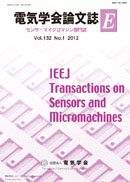All issues

Predecessor
- IEEJ Transactions on Industry Applications
- IEEJ Transactions on Electronics, Information and Systems
- IEEJ Transactions on Power and Energy
- IEEJ Transactions on Fundamentals and Materials
- The Journal of The Institute of Electrical Engineers of Japan
- The transactions of the Institute of Electrical Engineers of Japan.C
- The transactions of the Institute of Electrical Engineers of Japan.B
- The transactions of the Institute of Electrical Engineers of Japan.A
- The Journal of the Institute of Electrical Engineers of Japan
Volume 132, Issue 1
Displaying 1-9 of 9 articles from this issue
- |<
- <
- 1
- >
- >|
Paper
-
Satoshi Maruyama, Muneki Nakada, Makoto Mita, Takuya Takahashi, Hiroyu ...2012 Volume 132 Issue 1 Pages 1-9
Published: January 01, 2012
Released on J-STAGE: January 01, 2012
JOURNAL FREE ACCESSAn equivalent circuit model for the resonant-type vertical comb-driven optical MEMS (micro electro mechanical system) scanner has been developed based on the simple extension of the parallel-plate model. Both the electrostatic torque and the induction charge models are interpreted by using the equation-defined nonlinear dependent current source on the electrical circuit simulator platform. A systematic procedure has been investigated to fit the analytical model with the experimental results by using fitting parameters including the damping coefficient, the suspension width, and the comb gap. The developed simulation model has been used to verify a new control scheme to tune the scanner's oscillation amplitude in resonance by means of the pulse-width modulation of voltage at a given pulse height; the result indicates the effective use of digital electronics for the comb-driven optical scanner.View full abstractDownload PDF (1618K) -
Kensuke Kageyama, Hideaki Nagashima2012 Volume 132 Issue 1 Pages 10-15
Published: January 01, 2012
Released on J-STAGE: January 01, 2012
JOURNAL FREE ACCESSElectret condenser microphones (ECM) with perfluoroalkoxy (PFA) film lamination (FilmECMs) were fabricated and the microgap layers were formed between laminated films in the gap of FilmECM to enhance the electric field in the gap and the resonance frequency. The average sensitivity from 1 to 10 kHz and the resonance frequency of a single degree of freedom system were measured for fabricated FilmECMs. The average sensitivity of the FilmECM was increased with the increase in the number of film lamination in the gap while the resonance frequency was decreased. Moreover, the average sensitivity of FilmECM improved further by the application of boron nitride (BN) agglomerates on films in the gap. As a results, one of the fabricated FilmECMs demonstrated −54.5 dB (0 dB = 1 V/Pa) for the average sensitivity. Furthermore the significant degradation of the sensitivity was not observed up to 50 kHz for any samples though the sensitivity rising, which might be caused by the diffraction from the edge of the test fixture, was observed at around 20 kHz. Hence, FilmECM should have a great potential for a wideband mircrophone or an ultrasonic sensor.View full abstractDownload PDF (601K) -
Masatoshi Tsuji2012 Volume 132 Issue 1 Pages 16-21
Published: January 01, 2012
Released on J-STAGE: January 01, 2012
JOURNAL FREE ACCESSA method is proposed for detecting the lateral travel distance of a target via a simple system that is composed of sequential lobing in combination with two-frequency CW radar as well as a simple signal processing method that only uses four basic arithmetic operations. With this method the lateral travel speed is estimated by substituting [the measured angle error and the distance between the target and the sensor] for [the reciprocal of the angle error coherent to the system]. Experiments took place using an X-band sensor and the proposed method in order to measure the error involved. The results of the measurements were then used to propose a method of judging whether the detection rate of the target improved while also leading to a lower rate of false detections.View full abstractDownload PDF (626K)
Letter
-
Hisashi Oohira, Seiichi Serikawa2012 Volume 132 Issue 1 Pages 22-23
Published: January 01, 2012
Released on J-STAGE: January 01, 2012
JOURNAL FREE ACCESSAn electric distributed constant measuring system for underground pipeline safety inspection is constructed. In experiment, a ground resistance was used to simulate a real fault ground accident, and then the characteristic impedance and propagation constant were measured. It is confirmed that these measuring results change according to the accident position and ground resistance value. Therefore, it is considered that the accident position might be estimated by the deviation of the values.View full abstractDownload PDF (363K)
-
2012 Volume 132 Issue 1 Pages ES1_1-ES1_3
Published: January 01, 2012
Released on J-STAGE: January 01, 2012
JOURNAL FREE ACCESSDownload PDF (720K)
-
[in Japanese]2012 Volume 132 Issue 1 Pages NL1_1
Published: January 01, 2012
Released on J-STAGE: January 01, 2012
JOURNAL FREE ACCESSDownload PDF (468K) -
[in Japanese]2012 Volume 132 Issue 1 Pages NL1_2
Published: January 01, 2012
Released on J-STAGE: January 01, 2012
JOURNAL FREE ACCESSDownload PDF (655K) -
2012 Volume 132 Issue 1 Pages NL1_3
Published: January 01, 2012
Released on J-STAGE: January 01, 2012
JOURNAL FREE ACCESSDownload PDF (217K)
-
2012 Volume 132 Issue 1 Pages L1_1
Published: January 01, 2012
Released on J-STAGE: January 01, 2012
JOURNAL FREE ACCESSDownload PDF (122K)
- |<
- <
- 1
- >
- >|